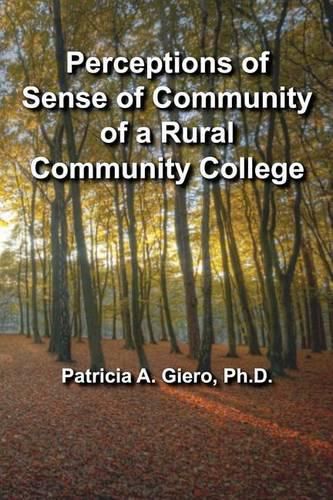Readings Newsletter
Become a Readings Member to make your shopping experience even easier.
Sign in or sign up for free!
You’re not far away from qualifying for FREE standard shipping within Australia
You’ve qualified for FREE standard shipping within Australia
The cart is loading…






This book is designed to provide knowledge of sense of community among traditional and nontraditional age students enrolled in online and traditional land-based learning environments. There is a gap in the literature regarding sense of community for students in different learning environments of rural community colleges. The author established the process of examining a sense of community for students of rural colleges. After reading the book, you will be able to take away information to be used to encourage course developers and online instructors to create and promote course activities that foster sense of community among students in online courses.
Key Book Words: academic institutions, active learning, adjunct faculty, adult learners, alienation, amotivation, anonymity, ANOVA, attitudes, attrition, belonging, blended course, blended learning, brick-and-mortar, campus experience, causal relationship, cause-and-effect relationship, civic activities, classroom community, collaborative activities, collaborative learning, college, community college, students, community members, connectedness, construct validities, constructivist learning, conversations, correlational design, culturally diverse, demographics, dependent variables, distance education, distance learning, economics, educational institutions, educators, emotional connection, employment, enrollment, environment, ethnic backgrounds, family, feedback, finance, focus groups, global society, health behaviors, health risks, high achievement, higher education, homogeneity, human growth, income differential, independent variable, instructor, interaction, interpersonal relationships, intrinsic motivation, isolation, job constraints, lack of community, lack of interaction, learner-instructor, learner-learner, learner-system, learners, loneliness, low-income, management, marital resources, members of society, minority students, motivation, non-traditional students, occupations, on-campus, online classes, online educators, online environment, online experience, online instructors, online learners, online students, online learning environment, peers, perceived learning, perceptions, personal perspective, physical-social interaction, poverty, psychological development, psychological sense of community, quality learning, real experiences, recommendations, reflective journals, reputation, research instrument, retention, rural communities, school learning, self-directedness, sense of belonging, sense of community, sense of feeling alienated, social activities, social change, social community, social context, social creatures, social desirability, social interaction, social isolation, social networks, social norms, socialization, student learning, student motivation, student perception, student status, teacher, teacher presence, teaching experience, teaching philosophy, teaching style, technological challenges, traditional classroom, traditional courses, traditional students, traditional students, unemployed, video streaming, virtual classroom, virtual environment, volunteers, web-based courses, web-based students, sense of community, online instruction, learning community, traditional students, non-traditional students, Asynchronous learning, blended learning environment, community, hybrid model of instruction, learning community, nontraditional students, online instruction, sense of community, traditional students, and traditional face-to-face instruction
$9.00 standard shipping within Australia
FREE standard shipping within Australia for orders over $100.00
Express & International shipping calculated at checkout
This book is designed to provide knowledge of sense of community among traditional and nontraditional age students enrolled in online and traditional land-based learning environments. There is a gap in the literature regarding sense of community for students in different learning environments of rural community colleges. The author established the process of examining a sense of community for students of rural colleges. After reading the book, you will be able to take away information to be used to encourage course developers and online instructors to create and promote course activities that foster sense of community among students in online courses.
Key Book Words: academic institutions, active learning, adjunct faculty, adult learners, alienation, amotivation, anonymity, ANOVA, attitudes, attrition, belonging, blended course, blended learning, brick-and-mortar, campus experience, causal relationship, cause-and-effect relationship, civic activities, classroom community, collaborative activities, collaborative learning, college, community college, students, community members, connectedness, construct validities, constructivist learning, conversations, correlational design, culturally diverse, demographics, dependent variables, distance education, distance learning, economics, educational institutions, educators, emotional connection, employment, enrollment, environment, ethnic backgrounds, family, feedback, finance, focus groups, global society, health behaviors, health risks, high achievement, higher education, homogeneity, human growth, income differential, independent variable, instructor, interaction, interpersonal relationships, intrinsic motivation, isolation, job constraints, lack of community, lack of interaction, learner-instructor, learner-learner, learner-system, learners, loneliness, low-income, management, marital resources, members of society, minority students, motivation, non-traditional students, occupations, on-campus, online classes, online educators, online environment, online experience, online instructors, online learners, online students, online learning environment, peers, perceived learning, perceptions, personal perspective, physical-social interaction, poverty, psychological development, psychological sense of community, quality learning, real experiences, recommendations, reflective journals, reputation, research instrument, retention, rural communities, school learning, self-directedness, sense of belonging, sense of community, sense of feeling alienated, social activities, social change, social community, social context, social creatures, social desirability, social interaction, social isolation, social networks, social norms, socialization, student learning, student motivation, student perception, student status, teacher, teacher presence, teaching experience, teaching philosophy, teaching style, technological challenges, traditional classroom, traditional courses, traditional students, traditional students, unemployed, video streaming, virtual classroom, virtual environment, volunteers, web-based courses, web-based students, sense of community, online instruction, learning community, traditional students, non-traditional students, Asynchronous learning, blended learning environment, community, hybrid model of instruction, learning community, nontraditional students, online instruction, sense of community, traditional students, and traditional face-to-face instruction